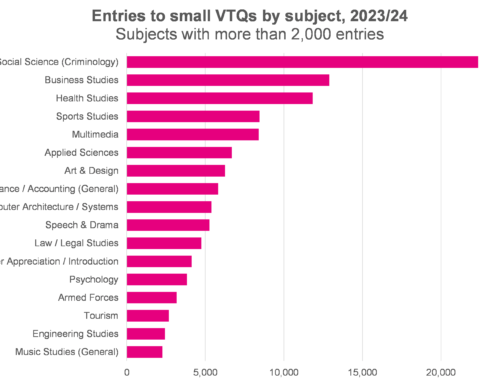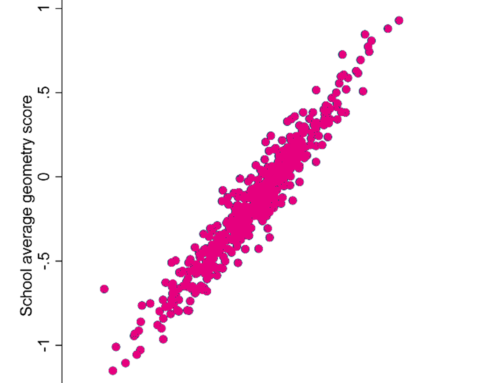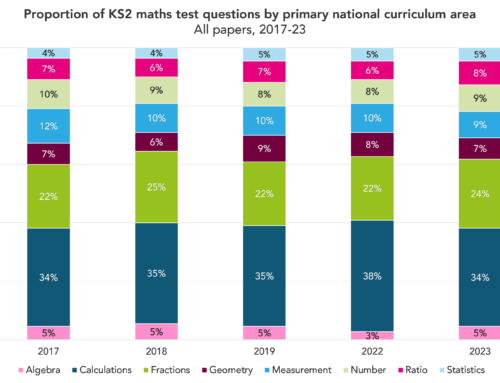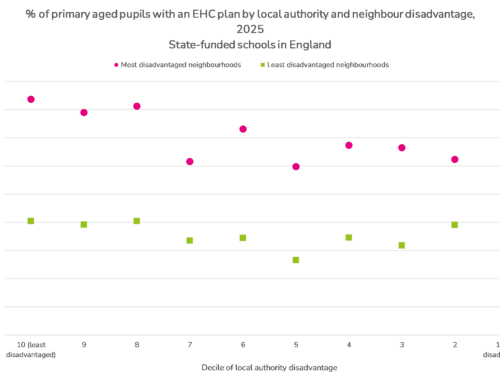A few months back, I wrote a piece about intersectionality and Key Stage 5 subject choice, and promised to write a series getting into different subject areas in more depth. That series is now upon us, and I’m starting with a look at STEM subjects.
Lack of diversity in those studying STEM subjects is an issue that’s widely discussed – and we’ve touched on it in some of our posts on subject choice. But what we haven’t written about is how these areas interact with one another. In this post, I’ll be looking at interactions between gender, ethnicity and disadvantage.
I’ll look both at data on all Level 3 STEM qualifications, and separately at some individual qualifications. These will include the most popular STEM A-Levels (maths, biology, chemistry, physics, computer science and further maths) and the most popular vocational and technical qualification (BTEC applied sciences). The entry numbers for other qualifications are substantially lower and unfortunately do not allow for this type of analysis.
Data
I’ll be using data from the KS5 exam, KS4 pupil and census tables of the National Pupil Database. We include those who completed KS4 in 2022 at a mainstream, state-funded school in England and who went on to complete KS5 exams in 2024.
Qualifications counted as Level 3 STEM qualifications include A-Levels, AS-Levels, T-Levels, IBO higher level components, L3 BTECs, L3 VRQs and Cambridge Technicals.[1]
Gender vs ethnicity
If we look across all Level 3 STEM qualifications, there is a gender difference in uptake, but it’s perhaps not as large as we might expect: 21% of female pupils who completed KS4 in a state-funded mainstream school went on to take at least one, compared to 27% of male pupils. But this masks considerable differences at the subject level, with female pupils being more likely to go on to take, for example, a qualification in biology, and less likely to take physics or computer science.
There are also some big differences by ethnic background, with pupils from Gypsy and Roma, Irish Heritage Traveller and Mixed White / Black Caribbean backgrounds being the least likely to go on to take a L3 STEM qualification, and those from Chinese, Indian and other Asian backgrounds being the most likely.
Let’s look at how the gender gap compares across pupils from different ethnic backgrounds. Note that, due to small numbers, some figures have been suppressed.
On the chart below, you can use the dropdown menu to select a subject of interest. A positive gender gap indicates that more female pupils went on to enter a qualification, and a negative gap more male pupils.
When we look at all L3 STEM qualifications, we see negative gaps for almost all ethnic backgrounds, which indicates that male pupils were more likely to go on to enter than female pupils. The negative gaps are larger for pupils from other White and Bangladeshi backgrounds and smaller for those from Gypsy and Roma and Black African backgrounds. Among those from other Black backgrounds there is a small positive gap, indicating that female pupils were slightly more likely to go on to enter an L3 STEM qualification than male pupils.
But, again, the overall picture masks differences at subject level.
Across every ethnic background, male pupils were more likely than female pupils to go on to enter A-Level physics, computer science, maths or further maths. And across every ethnic background, female pupils were more likely to go on to take A-Level chemistry or biology. Gender gaps in applied sciences BTECs, on the other hand, were low or zero across all ethnic backgrounds.
The biggest difference between ethnic backgrounds is in A-Level physics, for which the gender gap is -16 percentage points for pupils from a Chinese background, and just -2 percentage points for those from a Black Caribbean background. There is a similar pattern in A-Level computer science and further maths.
For a bit more context, let’s look at the actual proportion of male and female KS4 pupils who went on to take various STEM qualifications, rather than just looking at the gender gaps. Again, in the charts below you can use the dropdown menu to select a subject of interest.
In the group with the smallest gender gap, pupils from an other Black background, 26% of both male and female KS4 pupils went on to enter an L3 STEM qualification. While in the group with the biggest gender gap, those from an other White background, the figures are 24% for female pupils and 33% for male pupils.
FSM6 vs ethnicity
Disadvantaged pupils (here defined as those eligible for free school meals in the last six years) tend to be less likely than their peers to go on to enter a Level 3 STEM qualification: 14% did so last year, compared to 27% of their peers. This is, if anything, smaller than the difference in progression to a Level 3 qualification in any subject: 39% of disadvantaged pupils progressed last year, compared to 65% of their peers.
When broken down by ethnic background, we see some interesting differences between groups.
On the chart below, you can use the dropdown menu to select a subject of interest. A positive disadvantage gap indicates that more disadvantaged pupils went on to enter a qualification, and a negative gap more of their peers.
When we look at all L3 qualifications, the gap is negative for all groups, indicating that disadvantaged pupils were less likely to go on to enter these qualifications than their peers. The negative gaps are smallest for those from Gypsy and Roma, Black Caribbean and other Black backgrounds. Gaps are particularly high for those from White Irish, Mixed White / Asian, and Indian backgrounds.
Broadly speaking, we see a similar pattern when we look at individual A-Level subjects, with a few exceptions. One is further maths, in which the negative disadvantage gap is largest for pupils from a Chinese background.
And when we look at BTEC applied sciences, we see very different patterns. Disadvantaged pupils were slightly more likely to go on to enter these qualifications than their peers, but this does vary by ethnic background.
For more context, let’s look at the proportion of disadvantaged KS4 pupils and their peers who went on to study STEM qualifications, rather than just at the gaps. Again, you can use the dropdown menu to choose a subject of interest.
Among the group with the biggest disadvantage gap in terms of percentage points, those from a White Irish background, 9% of FSM6 pupils went on to take a L3 STEM qualification compared to 31% of their peers. Among the group with the smallest gap, those from a Gypsy and Roma background, the figures were 1% and 4%.
Gender vs FSM6
We’ve seen already that the gender gap in progression to Level 3 STEM qualifications is not that large, and this holds true for both disadvantaged pupils and their peers.
The chart below shows the proportion of KS4 pupils who went on to enter qualifications, broken down by disadvantage and gender.
But there are some big differences when we use the dropdown menu to look subject-by-subject. Female pupils were more likely than male pupils to progress to both biology and chemistry A-Level, but that gap was smaller among disadvantaged pupils than their peers. In the other STEM A-Levels, female pupils were less likely to progress, but again the difference is smaller for disadvantaged pupils.
There was virtually no gender gap in progression to applied sciences BTECs, and that holds true for disadvantaged pupils and their peers.
Three-way interactions
Finally, let’s look at what happens when we include all three characteristics: gender, ethnicity and disadvantage. We’ve included the entire list, including a subject-by-subject breakdown, here as an appendix. Please note that some of the resulting groups are quite small, so bear this in mind when interpreting the data.
The groups most likely to progress from KS4 to complete a STEM Level 3 qualification at KS5 were:
- male, non-disadvantaged pupils from Chinese backgrounds
- female, non-disadvantaged pupils from Chinese backgrounds
- male, disadvantaged pupils from Chinese backgrounds
- male, non-disadvantaged pupils from Indian backgrounds
- male, non-disadvantaged pupils from other Asian backgrounds
The groups least likely to progress were:
- female, non-disadvantaged pupils from Gypsy and Roma backgrounds
- female, disadvantaged pupils from White British backgrounds
- female, disadvantaged pupils from mixed White / Black Caribbean backgrounds
- male, disadvantaged pupils from mixed White / Black Caribbean backgrounds
- male, disadvantaged pupils from White British backgrounds
We should note that we have suppressed data on some groups due to small numbers.
The biggest differences in an individual subject are for maths, in which the group most likely to progress was male, non-disadvantaged pupils from a Chinese background: 58% of these pupils went on to take A-Level maths. The group least likely to progress (not including those for whom figures have been suppressed) was female, disadvantaged pupils from a Mixed White and Black Caribbean background: just 1% of these pupils went on to take A-Level maths.
Summing up
It’s quite common to hear progression to STEM subjects talked about as if the issues are common to all STEM qualifications. But it’s important to remember that there are big differences.
We should also bear in mind that some of the differences in progression to L3 STEM qualifications will be common to progression to any L3 qualification.
That said, there are differences that are particular to STEM and to individual subjects within STEM. One of the most striking of these is gender differences, and we’ve seen that these seem to affect pupils from all ethnic backgrounds and from disadvantaged and non-disadvantaged backgrounds. But they do not affect all of these groups equally, with gender gaps far lower for some groups in some subjects.
[1]: A-Levels counted as STEM include: biology, chemistry, physics, computer science, maths, statistics and further maths. T-Levels counted as STEM include: building services engineering for construction, design and development for engineering and manufacturing, engineering, manufacturing, processing and control, maintenance, installation and repair for engineering and manufacturing, and health and science.
Other qualifications are counted as STEM are those with one of the following subject sector areas: science and mathematics, engineering and manufacturing technologies and digital technology.
Want to stay up-to-date with the latest research from FFT Education Datalab? Sign up to Datalab’s mailing list to get notifications about new blogposts, or to receive the team’s half-termly newsletter.









Leave A Comment